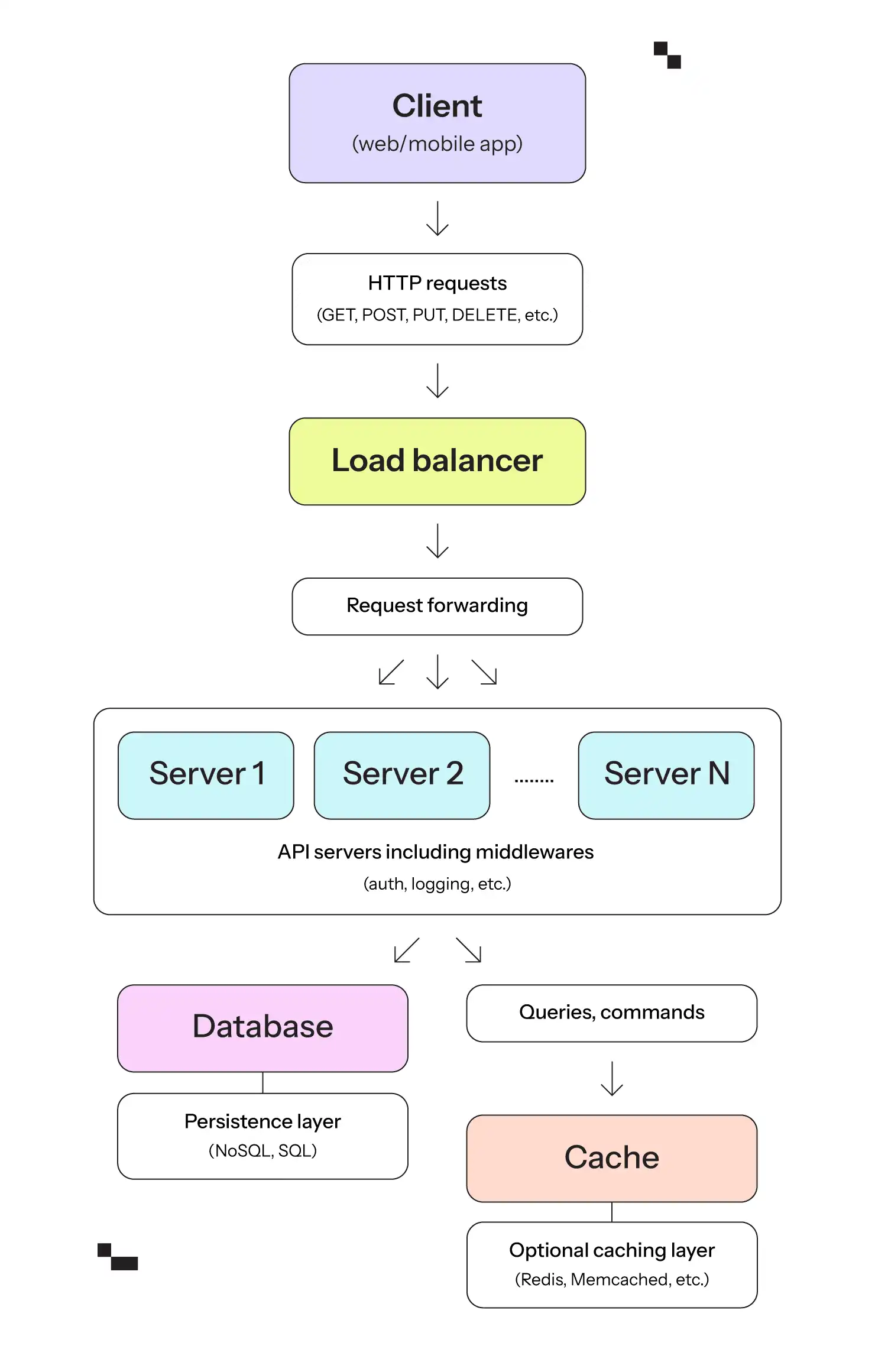
Understanding RESTful API design principles
APIDevOpsmicroservicesresource allocation
19 December 2024
RESTful APIs allow client applications to access and manipulate resources (data) hosted on a remote server using a standardized set of rules and protocols. REST stands for representational state transfer, which is a set of architectural principles that define how to design and implement these interfaces. Key principles of RESTful design include using HTTP methods—like POST, GET, PATCH, and DELETE—to perform CRUD (create, read, update, delete) operations, identifying resources through unique URLs, and transferring data in a lightweight format like JSON. RESTful APIs provide a flexible and standard way for systems to communicate with each other over the internet, making them a fundamental building block of modern web and mobile applications.
This article covers the fundamentals of RESTful API design. By the end, we'll explore key REST principles, how they compare to other paradigms, and best practices for designing RESTful APIs.
API design principles
Before getting into the details, let's briefly review how RESTful compares to other popular API design methodologies.
RESTful
As mentioned, REST APIs are structured around resources (nouns) rather than actions, utilizing standard HTTP methods (GET, POST, PUT, DELETE) to manipulate those resources. RESTful APIs are built around several key principles for consistent and scalable web services:
- Stateless communication. REST API requests contain all necessary information, with no client context stored on the server between requests.
- Uniform interface. This principle ensures consistent resource identification and manipulation through self-descriptive messages using standard HTTP headers and status codes. It also incorporates HATEOAS (hypermedia as the engine of application state), allowing clients to discover API capabilities dynamically.
GraphQL
Created by Facebook, GraphQL is a query language and runtime that allows more efficient and flexible data retrieval than traditional REST endpoints. Its core design principles are as follows:
- Query flexibility. This allows clients to specify what data they need in the response. This means that multiple resources can be requested in a single query while eliminating overfetching and underfetching of data.
- Single-endpoint architecture. It routes all requests through one endpoint, differentiating operations by query vs. mutation types. A schema defines all possible operations and types within the architecture.
- Strong typing system. This serves as a contract between client and server, providing built-in type validation and documentation while enabling powerful developer tools and type checking.
gRPC
Created by Google, gRPC is a remote procedure call (RPC) framework based on HTTP/2. It operates based on the following core principles:
- Contract-first development. Uses Protocol Buffers (protobuf) as a strict interface definition language (IDL), enabling automatic code generation for both client and server implementations.
- Streaming support. Includes unary, server, client, and bidirectional streaming capabilities, making it efficient for real-time communication and large data transfers, particularly in microservices communication.
- Binary protocol. It uses HTTP/2 as its transport layer, which offers highly efficient binary serialization. This results in lower latency and better performance compared to text-based protocols.
Overview of API design principles
Here's a table that summarizes some of the differences between these designs:
| REST | GraphQL | gRPC | |
| Use cases | Best for CRUD (create, read, update, delete) operations and standard resource retrieval | Best for complex queries and scenarios where clients need specific data | Best for microservices and high-performance applications requiring real-time communication |
| Data format | JSON and XML, among others | JSON | Protocol Buffers (binary) |
| Request style | Resource-oriented (CRUD) | Query-oriented | Procedure-oriented |
| Caching | Built-in HTTP caching | Custom implementation required | Custom implementation required |
| Type safety | No built-in type safety | Strong type system | Strong type system |
| Error handling | Standard HTTP status codes | Custom error responses via JSON | Custom error handling via Protocol Buffers |
RESTful API architecture overview
A system using a RESTful API typically includes three key components: the client, server, and database. It also includes additional elements like a load balancer, caching, and authentication service.

Client
The client is any application or device that consumes the API. This could be a web browser, mobile app, or another server in a microservices architecture. Clients send requests to the server using HTTP methods (_eg_ GET, POST, PUT, DELETE) to perform CRUD operations on resources—for example, a mobile app that retrieves user data by making a GET request to https://api.example.com/users.
API server
The server hosts the API and is responsible for processing incoming client requests, interacting with the database or other services, and returning responses. The server interprets the HTTP requests, performs the necessary operations (such as creating, retrieving, updating, or deleting resources), and returns the appropriate HTTP status codes and data.
Middleware makes up optional layers that can be integrated into the server architecture to handle additional functionalities. This can include authentication, logging, data validation, error handling, and request/response transformations. Middleware processes requests before they reach the server's core logic and can also modify responses before they are sent back to the client.
Database
The database stores the application data. It can be a relational database (like PostgreSQL or MySQL), a NoSQL database (like MongoDB), or any other form of data storage. The server uses the database to persistently store and retrieve data, such as user information, product details, or transaction histories.
Within the database, a caching layer stores copies of frequently requested data to reduce the need to access the database repeatedly. It helps reduce latency by serving data from the cache instead of querying the database every time. This is often achieved using in-memory databases, such as Redis or Memcached.
Load balancer
A load balancer can be used to distribute incoming client requests across multiple server instances. This helps to ensure high availability and scalability, preventing any single server from becoming a bottleneck. It balances traffic among multiple server instances to improve response times, provides fault tolerance by rerouting requests if a server becomes unresponsive, and can also handle SSL termination to offload encryption and decryption from the servers.
Key characteristics of REST APIs
REST APIs are based on several core principles that define their architecture and behavior.
Client-server architecture
In a RESTful API architecture, the client and server operate independently. The client (eg. a web browser or mobile app) is responsible for the user interface and initiates requests, while the server handles data processing and responses. This separation of concerns leads to long-term maintainability and flexibility.
For example, a mobile app can interact with the REST server using its API without needing to understand implementation details. If the backend API includes user interface code, it creates tight coupling between client and server, creating dependency issues and making updates harder.
Stateless communication
As mentioned, in a stateless architecture, each request from the client to the server contains all the information needed to process the request. The server does not store any client-specific session data. This makes it easier for the API server layer to scale horizontally. Since each request is self-contained, servers can handle them independently, which simplifies load balancing. It also means that servers don't need to store session state, reducing memory overhead.
For example, a login API call must include user credentials in each request rather than relying on a session ID stored on the server. This allows any server in a cluster to handle the request without needing prior context. If a server relies on session data stored between requests, it complicates scaling and makes it difficult for load balancers to distribute requests evenly.
Cacheable responses
RESTful APIs' responses can be cached, allowing clients or intermediaries to store responses for a certain time. This minimizes the need for repeated requests for the same data. Cached data can be served faster than querying the server every time. It also reduces latency and server load, which improves user experience and scalability.
An API response can include caching headers like Cache-Control and Expires, enabling the client to store the data temporarily and avoid unnecessary calls to the server. For example, a weather API response that is cacheable could reduce the need for frequent updates if the data remains unchanged for an hour. If responses lack caching headers, clients will repeatedly request the same data, adding unnecessary load to the server and slowing down the response time for the end user.
Layered system
A layered system allows APIs to operate across multiple layers—such as intermediaries, load balancers, and gateways—without the client being aware of these layers. This approach provides added security and scalability. For example, load balancers can help distribute traffic without the client needing to know how the load is balanced. This modularity makes it easier to scale or secure parts of the system without redesigning the whole API.
When a client makes a call to an API, it can be automatically routed through a load balancer and firewall, ensuring optimized performance and security without altering the client code. If a client has to directly interact with multiple backend servers or understand how requests are distributed, it introduces complexity and breaks the layered abstraction.
Uniform interface
Another core principle of REST APIs is the Uniform Interface constraint, which is a set of standard rules for interacting with the API. This includes consistent use of HTTP methods (GET, POST, PUT, DELETE), standard URL patterns, and predictable response formats. A uniform interface improves the API's usability, making it easier for developers to predict how the API will respond to requests. This consistency reduces the learning curve and the likelihood of errors.
A RESTful API uses HTTP methods consistently across resources (eg. GET /users retrieves users, POST /users creates a user), which ensures uniformity and predictability. An API that uses nonstandard methods or mixes HTTP methods (eg. using GET to create a resource) can confuse developers and make the API harder to use reliably.
Code on demand
Code on demand is an optional REST architectural constraint that enables servers to extend client functionality by transmitting executable code like JavaScript to clients at runtime, such as loading dynamic widgets or updating UI components without a page refresh.
This enables the client to extend functionality dynamically without needing to update its code. It provides flexibility and can enhance functionality by letting clients execute code directly from the server, especially in dynamic web applications.
Conclusion
This article explored the concept of RESTful API design principles and the essential components that make an API RESTful. This started with an overview of API design alternatives and a topology of typical RESTful system architecture along with a deep dive into the key components of RESTful APIs. Adhering to RESTful API design principles can improve code quality and ensure that your APIs serve users effectively and efficiently, making your application more successful in the long run.
Upsun frees modern development teams to easily experiment, quickly iterate, and effortlessly scale on every dimension. It's a self-service, fully managed, secure, developer-focused cloud application platform with built-in observability, multicloud edge caching, reliable deployment, and the freedom to choose your stack and cloud provider. With Upsun, you can build and run RESTful API applications using programming languages and frameworks of your choice. You have complete control over how to scale applications (horizontally or vertically) while Upsun manages the heavy lifting, including resource allocation and traffic surges.
Your greatest work
is just on the horizon
CompareVercel alternativeAmazee alternativeHeroku alternativePantheon alternativeManaged hosting alternativeFly.io alternativeRender alternativeAWS alternativeAcquia alternativeDigitalOcean alternative
Join our monthly newsletter
Compliant and validated